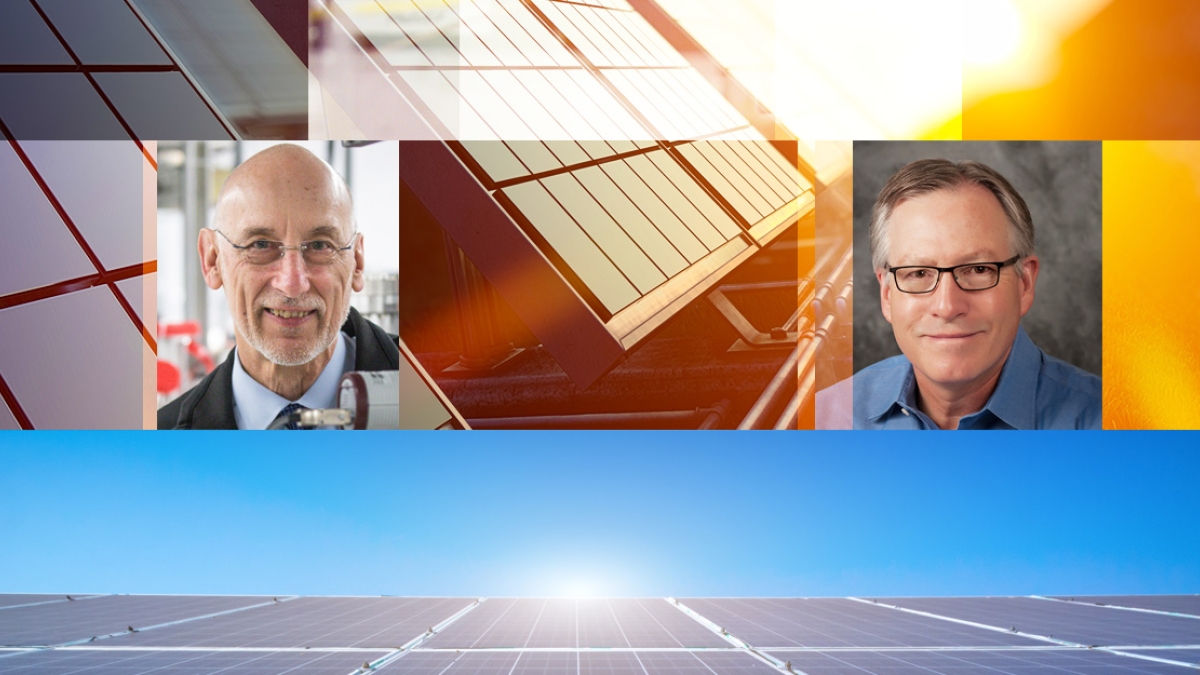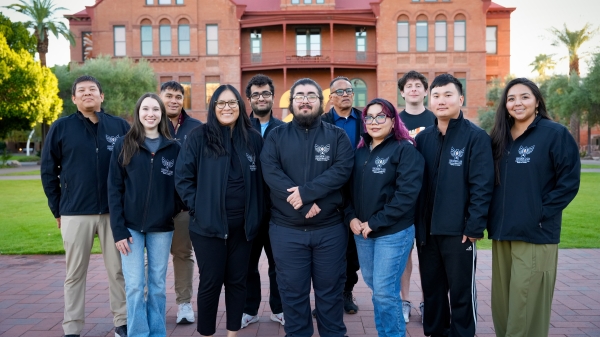ASU leads new research center to power up electrical grid

Ultra EFRC is headed by Regents Professor of physics Robert Nemanich (left) and Professor of electrical engineering Stephen M. Goodnick. Photo illustration by Patrick Cheung
A U.S. Department of Energy award is empowering a new center at Arizona State University to create a more resilient and sustainable electricity grid with the use of next-generation materials.
The four-year, $12.4 million award from the DOE’s Office of Basic Energy Sciences establishes an Energy Frontier Research Center headquartered at ASU called Ultra Materials for a Resilient, Smart Electricity Grid, or Ultra EFRC. While ASU will lead Ultra EFRC, researchers from the University of Alabama at Birmingham, University of California Riverside, Cornell University, Michigan State University, Sandia National Laboratories, Stanford University and the University of Bristol will work within its framework.
Established in 2009 by the DOE, the EFRC program brings together “creative, multidisciplinary scientific teams to tackle the toughest scientific challenges preventing advances in energy technologies.”
Headed by Regents Professor of physics Robert Nemanich and Professor of electrical engineering Stephen M. Goodnick, Ultra EFRC will investigate fundamental questions about wide band gap semiconductors.
Wide band gap semiconductors are made of materials such as aluminum nitride, boron nitride or diamond, which possess extraordinary physical and electrical properties that allow them to operate at higher temperatures, voltages and frequencies. This makes power electronics constructed from wide band gap materials significantly more powerful and energy efficient than conventionally used silicon-based semiconductors.
“We recognized there was a huge need to really understand these materials from a fundamental point of view, because they work differently than other semiconductors,” said Nemanich, Ultra EFRC’s director.
“What we don’t understand about these materials is really what’s keeping them from reaching their potential,” said Goodnick, a professor in the Ira A. Fulton Schools of Engineering and the deputy director of Ultra EFRC.
Ultra EFRC’s examination of these materials is in service of electricity grids, which Nemanich and Goodnick note are due for an overhaul.
Since its inception in the late 19th century, the American electricity grid has grown from a disconnected patchwork of small, localized systems into an immense web of power generation and transmission on federal, state and local levels.
“The old grid was based on big spinning magnet transformers taking power from very high voltage to what you use in your house,” Goodnick said. “Over the past couple of decades, those transformers have been replaced by power electronics and semiconductors.”
This transition has made components of the grid smaller, and Ultra EFRC aims to make grid infrastructure smaller still.
“If you look at a power substation, it’s huge — a city block that's full of transformers,” Nemanich said. “If some electrical switch breaks, the whole thing goes down.”
But through the use of wide band gap materials, power substations could potentially shrink a hundredfold — to virtually the size of a suitcase — saving space and increasing the reliability of the grid.
“With a much smaller system, then you can have a lot of resiliency. You can build it right in,” Nemanich said. “If there's a failure, you just switch over right away.”
Wide band gap materials can also better integrate renewable energy sources into the electricity grid. While electricity grids originally only delivered power in one direction — from power plants to consumers — today’s grid must feed and take power as needed. Renewable energy sources such as wind and solar power supply power under the right conditions, but their cells and batteries require recharging when it’s not windy or sunny.
“We need a smart grid to be able to handle these bidirectional needs,” Nemanich said.
Goodnick and Nemanich, frequent collaborators of the last seven years, attribute the transdisciplinary nature of ASU for providing an environment for Ultra EFRC to take root.
“It’s sort of built into the character of the faculty and the way everybody interacts,” Nemanich said. “Steve is in electrical engineering, I'm in physics, other people may be in material science or materials engineering, and you have to have a way that the faculty can work together, share equipment, and build something that's bigger than just the sum of the efforts. And that's the environment that ASU is able to give to our faculty and students.”
More Science and technology

Indigenous geneticists build unprecedented research community at ASU
When Krystal Tsosie (Diné) was an undergraduate at Arizona State University, there were no Indigenous faculty she could look to…

Pioneering professor of cultural evolution pens essays for leading academic journals
When Robert Boyd wrote his 1985 book “Culture and the Evolutionary Process,” cultural evolution was not considered a true…

Lucy's lasting legacy: Donald Johanson reflects on the discovery of a lifetime
Fifty years ago, in the dusty hills of Hadar, Ethiopia, a young paleoanthropologist, Donald Johanson, discovered what would…